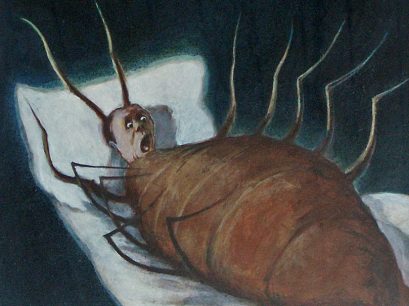 By FRANZ KAFKA (http://records.viu.ca/~johnstoi/stories/kafka-E.htm; 1915/2009)
By FRANZ KAFKA (http://records.viu.ca/~johnstoi/stories/kafka-E.htm; 1915/2009)
You likely know the story of this German novella whether you’ve actually read it or not: the overworked, anxiety-prone Gregor Samsa awakens one morning to find himself transformed into a giant beetle (not a cockroach as is commonly claimed). His mother, father and sister, with whom he lives and supports, freak out; above all else they’re irritated that Samsa can no longer work. Samsa in the meantime attempts unsuccessfully to adjust to life as an insect. He finally dies from neglect and an apple stuck in his back that causes a deadly infection.
THE METAMORPHOSIS is arguably the crowning achievement of the legendary Franz Kafka (1883-1924). Not too many writers can claim to have a literary term named after them, but Kafkaesque is a viable and much-used word. Those looking for a working definition of Kafkaesque should read this novella, which is justly world famous, but also quite misunderstood.
Fact: it’s not the protagonist becoming an insect that makes this the masterpiece it is, but the way Kafka treats the situation (Kafka apparently insisted to his original publisher that the beetle critter that gives the book its title not be pictured on the cover) . Gregor Samsa’s bizarre tale unfolds not as a melodramatic horror fest or surreal mindbender, although in many respects Kafka chose the most strangest, most subversive manner imaginable to tell this story: as a frank and unadorned drama. Note the oddly matter-of-fact way Kafka relates Samsa’s awakening in the opening scenes—he might as well be describing the experience of waking up to find a zit on one’s nose. Kafka’s overriding interest, of course, is not in what Samsa turns into but the accompanying feelings of awkwardness and revulsion, which of course are things we can all relate to.
Another strange facet of this story is the fact that it’s so uncannily realistic and convincing. While I’ve never experienced turning into a cockroach, I’ll have to conclude that were I to do so the results would be very much as Kafka describes them. That sense of realism extends to the behavior of Samsa’s family, from his loving but finally apathetic sister to his unstable father, who finds work as a servant and takes to sleeping in his uniform, and his mother, who doesn’t initially see Gregor in metamorphosed form—and faints once she does.
There’s also the question of what all this “means.” I’ve read quite a few over-intellectualized analyses of THE METAMORPHOSIS that interpret Gregor Samsa’s predicament in all sorts of different ways. While the tale, like any great work of art, is certainly open to a myriad of interpretations, I think it works best as just what it is: a simple and contained story of a man who turns into an insect.
Finally, the translation under review is a newly prepared e-text by Ian Johnston. It’s reasonably smooth and uncluttered, and succeeds in conveying the mood and feel of previous translations (of which I’ve read a couple). There exist quite a few English versions of this work, and I’ve no idea which of them (if any) is definitive, but THE METAMORPHOSIS is required reading in any form.
